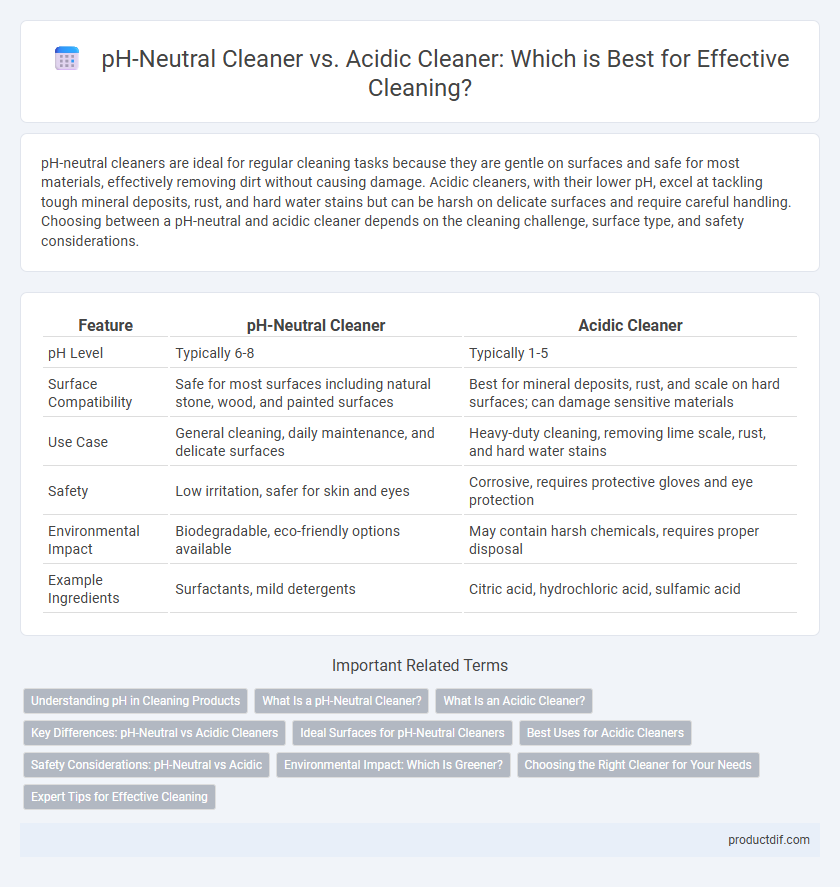pH-neutral cleaners are ideal for regular cleaning tasks because they are gentle on surfaces and safe for most materials, effectively removing dirt without causing damage. Acidic cleaners, with their lower pH, excel at tackling tough mineral deposits, rust, and hard water stains but can be harsh on delicate surfaces and require careful handling. Choosing between a pH-neutral and acidic cleaner depends on the cleaning challenge, surface type, and safety considerations.
Table of Comparison
| Feature | pH-Neutral Cleaner | Acidic Cleaner |
|---|---|---|
| pH Level | Typically 6-8 | Typically 1-5 |
| Surface Compatibility | Safe for most surfaces including natural stone, wood, and painted surfaces | Best for mineral deposits, rust, and scale on hard surfaces; can damage sensitive materials |
| Use Case | General cleaning, daily maintenance, and delicate surfaces | Heavy-duty cleaning, removing lime scale, rust, and hard water stains |
| Safety | Low irritation, safer for skin and eyes | Corrosive, requires protective gloves and eye protection |
| Environmental Impact | Biodegradable, eco-friendly options available | May contain harsh chemicals, requires proper disposal |
| Example Ingredients | Surfactants, mild detergents | Citric acid, hydrochloric acid, sulfamic acid |
Understanding pH in Cleaning Products
pH-neutral cleaners have a balanced pH level around 7, making them safe for most surfaces and effective for everyday cleaning without causing damage or discoloration. Acidic cleaners typically have a pH below 7 and are designed to remove tough mineral deposits, rust, and hard water stains but may damage sensitive materials like marble or natural stone. Understanding the pH in cleaning products helps select the appropriate cleaner for specific tasks, ensuring optimal cleaning performance and surface protection.
What Is a pH-Neutral Cleaner?
A pH-neutral cleaner maintains a balanced pH level around 7, making it gentle on surfaces and safe for frequent use on materials like wood, tile, and stone. It effectively removes dirt and grime without causing damage or discoloration, unlike acidic cleaners which have a lower pH and can corrode or etch certain surfaces. Ideal for everyday cleaning tasks, pH-neutral cleaners preserve the integrity of surfaces while ensuring thorough cleanliness.
What Is an Acidic Cleaner?
An acidic cleaner contains a lower pH, typically below 7, making it effective at dissolving mineral deposits, rust, and hard water stains. These cleaners often include ingredients like citric acid, phosphoric acid, or hydrochloric acid, which target inorganic buildup on surfaces such as tiles, metal, and bathroom fixtures. Acidic cleaners provide powerful results for tough grime but must be used with caution on sensitive materials to avoid damage.
Key Differences: pH-Neutral vs Acidic Cleaners
pH-neutral cleaners maintain a balanced pH of around 7, making them safe for a wide range of surfaces without causing damage or discoloration. Acidic cleaners, with a pH typically below 7, are highly effective at removing mineral deposits, rust, and hard water stains but can corrode sensitive materials like stone, grout, or metal if not used properly. Choosing between pH-neutral and acidic cleaners depends on the cleaning task, surface type, and frequency of use to ensure optimal results and longevity of the materials.
Ideal Surfaces for pH-Neutral Cleaners
pH-neutral cleaners are ideal for delicate surfaces such as natural stone, hardwood floors, laminated materials, and painted walls because they maintain the surface's integrity without causing etching or discoloration. These cleaners effectively remove dirt and grime without compromising finishes, making them suitable for daily maintenance in homes and offices. Unlike acidic cleaners, pH-neutral products reduce the risk of damaging sensitive materials, extending the lifespan of valuable surfaces.
Best Uses for Acidic Cleaners
Acidic cleaners are best suited for removing mineral deposits, rust stains, and hard water residues from surfaces like tiles, porcelain, and metal fixtures. Their low pH composition effectively dissolves calcium, lime scale, and other alkaline substances that neutral or alkaline cleaners cannot remove efficiently. Ideal applications include bathroom and kitchen descaling, heavy-duty appliance cleaning, and restoring the shine on stainless steel and chrome fittings.
Safety Considerations: pH-Neutral vs Acidic
pH-neutral cleaners offer enhanced safety for both users and surfaces by minimizing the risk of skin irritation and material corrosion, making them suitable for regular use on sensitive or delicate items. Acidic cleaners, while effective at removing mineral deposits and rust, require careful handling due to their potential to cause chemical burns and damage certain surfaces if misused. Proper storage, usage of protective gear, and adherence to manufacturer guidelines are essential to safely manage the risks associated with acidic cleaning products.
Environmental Impact: Which Is Greener?
pH-neutral cleaners are generally greener due to their biodegradable ingredients and minimal impact on aquatic ecosystems, reducing water pollution risks. Acidic cleaners can cause soil and water acidification, harming plant and marine life, thus requiring careful disposal and dilution. Choosing pH-neutral options supports sustainable cleaning practices with lower environmental toxicity and safer waste management.
Choosing the Right Cleaner for Your Needs
pH-neutral cleaners provide gentle, effective cleaning suitable for delicate surfaces like marble, wood, and laminates, minimizing damage risk and maintaining material integrity. Acidic cleaners excel at removing tough mineral deposits, rust, and hard water stains, making them ideal for bathrooms and kitchens with heavy buildup. Selecting the right cleaner depends on surface type and soil nature, ensuring optimal cleaning performance and surface protection.
Expert Tips for Effective Cleaning
pH-neutral cleaners preserve surfaces by maintaining a balanced pH level, reducing the risk of damage on sensitive materials like marble and hardwood. Acidic cleaners excel at dissolving mineral deposits and rust but require careful application to avoid corrosion on metals and grout discoloration. Experts recommend selecting cleaners based on surface type and contamination, using pH-neutral options for regular maintenance and acidic solutions for targeted mineral or alkaline residue removal.
pH-neutral Cleaner vs Acidic Cleaner Infographic

 productdif.com
productdif.com